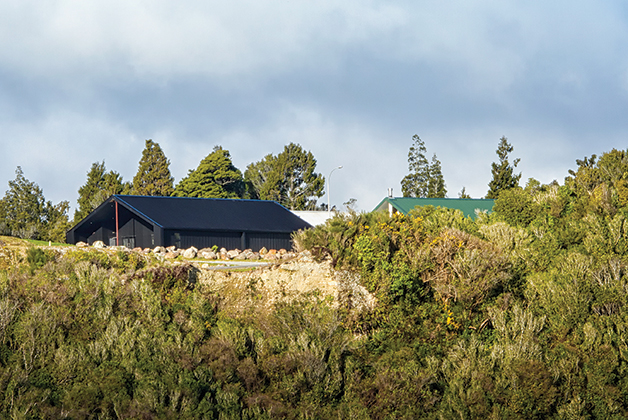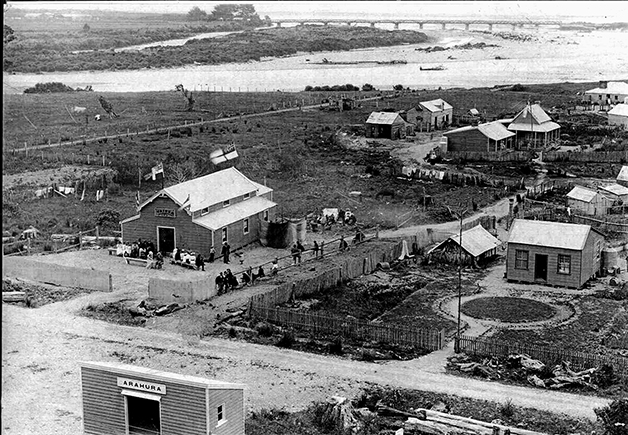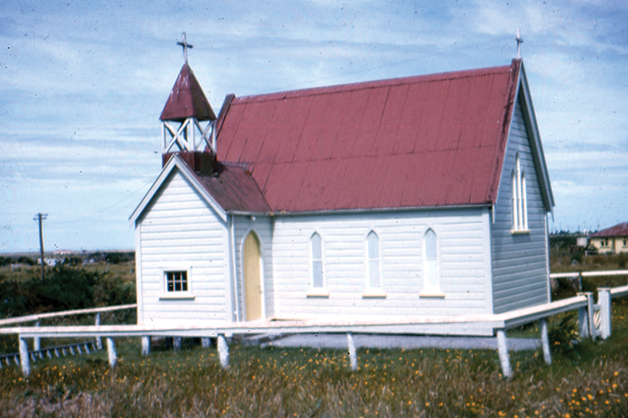Arahura dreaming
Oct 10, 2014

When Ngāti Waewae Rūnanga officially opens its new whare tipuna in November on the terrace overlooking the Arahura River and the ocean, it will realise a long-held dream.
Kaituhi Mark Revington reports.
It is a depressingly familiar story. In 1859 Poutini Ngāi Tahu entered into negotiations with the Crown for the purchase of Te Tai Poutini (West Coast). The Arahura Deed of Purchase was signed in 1860 between the leading Poutini chiefs and the Crown agent James MacKay at Māwhera Pā on the south side of the Māwhera (Grey River).
Historian Harry Evison records how Poutini Ngāi Tahu wanted to keep around 375,000 acres between the Māwhera (Grey) and Hokitika rivers but instead had to settle with 58 native reserves scattered throughout the Tai Poutini totalling 10,224 acres, including a 2000 acre reserve at Arahura.
Historian Harry Evison records how Poutini Ngāi Tahu wanted to keep around 375,000 acres between the Māwhera (Grey) and Hokitika rivers but instead had to settle with 58 native reserves scattered throughout the Tai Poutini totalling 10,224 acres, including a 2000 acre reserve at Arahura. In the 1860s part of the Arahura Māori Reserve was taken for rail and roading purposes, which is now State Highway 6 and the West Coast rail corridor, severing the Arahura Pā from its urupā.
As people poured onto the coast, seduced by the West Coast gold rushes of the 1850s and 1860s, land at Māwhera became more valuable. It sparked the Māwhera leases which would eventually become Greymouth. As Greymouth grew, the people of Māwhera began to move down the coast to Arahura to live with the families who were already there.
Over the next 140 years, those living at Arahura would congregate in a variety of buildings, from a church to a hall to a school and then a whare wānanga.
In November, when the striking new whare tipuna of Ngāti Waewae Rūnanga opens, it will realise a long-held dream, says former rūnanga chairman Ned Tauwhare.
“It’s fantastic. It’s just a shame that a lot of the old people who passed on recently and I’m talking the last 15 or 20 years, they didn’t get to see the result of that moemoeā we had.”
In 2006 Ngāti Waewae was gifted the land for the marae on the terrace overlooking the Arahura River by the Riki Te Mairaki Ellison Taiaroa Trust. At the time the trust was leasing the land to the Māwhera Incorporation who in turn sub-let it. Māwhera agreed to surrender the lease. That allowed the trust to gift the land to the rūnanga.
In 2008 plans were put forward for a marae to be built, with the project receiving a major boost in December 2009, when Lotteries granted $900,000 towards the project. Construction of stage one – office, ablutions and kitchen – started in March 2010, with the main building phase to follow once funding was secured.
Rūnanga chairman Francois Tumahai was operations manager and chief fund raiser. He estimates he managed around 25 presentations in a little under two years to raise money for the project. “I knocked on corporate doors, went to Lotteries, the Ngāi Tahu Fund, Solid Energy, Meridian… it was 18 months of knocking on doors and doing presentations to anybody and everybody. The sad thing is that they said they’d heard it all before because the project had been promised for a long time but hadn’t got off the ground.”
The striking black whare tipuna was designed by MAP Architects who were also responsible for Maahunui II at Tuahiwi. Its carvings have been supervised by Ngāi Tahu carver Fayne Robinson.
“Some people weren’t too sure about the black,” says Francois, “but once it went up they changed their minds. It’s stunning.”
Traditionally Arahura has been an important source of pounamu, and is of immense cultural significance for Ngāti Waewae. The original Arahura settlement by the river mouth moved to its current location on the state highway to escape the regular flooding that was occurring at the river mouth.
One of the first communal buildings established at Arahura was the St Paul’s Māori Anglican Church, which was opened on St Andrews Day, November 30, in 1871. The church was funded by the local Māori community and descibed in the local newspaper as being an “exceedingly pretty structure, thoroughly finished within and without”.
The famous Tairea Rūnanga Hall was located near the present site of the Arahura Whare Wānanga. The hall was opened in 1897 [and] included raising of the flag named Tama followed by speeches, a hākari and haka.
When the Reverend George Mutu visited Arahura in 1873, he reported that “there is a church that the natives are greatly proud of, capable of holding about 60 people, well built and arranged, and kept in scrupulous order”. He also described in detail “a very handsome room that had recently been completed for the purpose of holding meetings and discussions, and for general social purposes. It is very tastefully painted in old Māori style inside, and nicely carpeted with matting”.
The famous Tairea Rūnanga Hall was located near the present site of the Arahura Whare Wānanga. The hall was opened in 1897, an occasion that the local newspaper promised to be “one of the most unique and interesting entertainments ever witnessed in Westland”. The opening included raising of the flag named Tama followed by speeches, a hākari and haka.
Tairea Hall was used for a variety of purposes, including tangi, concerts, and fancy dress balls before falling into disrepair in the early 20th century. It was eventually pulled down.
Following a major flood in 1903, St Paul’s Church was moved from its original location near the river mouth to the main Greymouth-Hokitika highway, in line with the gradual movement of the Arahura settlement. The church was destroyed by a whirlwind in 1976, but until then had been a focal point for the community, says Horiana Tootell (nee Mason). “The whole community used our church – the Pākehā community up the valley, our neighbours – they all used St Paul’s.”
Jimmy Russell has similar memories. “St Paul’s was an Anglican church but other denominations used it. We had church service every Sunday and in the afternoons we had Sunday School. All our Pākehā friends from the Arahura Valley used to come to the church.”
The memories of those kaumātua interviewed for this story go back as far as the 1930s and 1940s, after the demise of Tairea Hall, and all have fond memories of growing up at Arahura.
Georgina Hilda Mason, affectionately known as Taua Tilly, is the last sibling alive out of 18 brothers and sisters. “Arahura was a living pā, my father had a farm. There were lots of fruit trees, plums next door, all sorts of fruit. There was no gorse growing in the pā. No broom. The pā was that beautiful. I can remember those market gardens, turnips and carrots, and all the pā kids swimming in the river.”
Ina Elizabeth Panapa-Pu, known locally as Nan Pu, was born at Arahura and warmly talks about life at the pā. “We had to go to church every Sunday. The hall was before our time. We would have church in the morning and then in the afternoons we used to have kapa haka at somebody’s place, and that was one of the things we used to do to raise money for the war effort. Church in the morning and kapa haka in the afternoon every Sunday.”
Violet Bradley, nee Russell, who was born at her grandmother’s house in Arahura in 1933, recalls everyone attending church services on Sunday. “Once we heard the bell ring, look out if we weren’t at church. Sometimes you wouldn’t have time to get changed but you just go.
“We had a beautiful pā, and we had aunties and uncles and grandparents who cared for the pā and kept it lovely. We would go and give them help as kids but they did all the work. It was a lovely pā for us kids.”
After Tairea Hall, tangi at Arahura were held at people’s houses. “A lot of our relations would come on the train from over the hill for major tangi. They would arrive at the station and there would be karanga and all that important stuff. I can still see it,” says Horiana.
In 1971, centennial celebrations were held for St Paul’s Church. “It was a major event for the church community and our pā. I can remember Canon Rangiihu came and assisted the Bishop of Christchurch. He came and stayed with my mother. At the time I was hapū. My mother asked him, did he have a name. He said he would think about it and went to bed, When he came out in the morning, he said he had a name. He called my baby Rautahi,” recalls Horiana.
In 1976 the church was demolished by a whirlwind. “Me and my wife were the second to last couple to be married there,” says Ned Tauwhare. “The day the whirlwind happened out there, one of our relations Sam Tainui was at Arahura visiting his mum, and he was at the railway station waiting for the rail cart to came in and he told us it was like a big roar coming up from the river.”
Most of the children from the pā attended the nearby Kaihinu School. They caught the train in the morning, and then had to walk home in the afternoon along the road or the railway track. Following concern from parents about the dangers of the long walk home, the Arahura Māori School was opened in the pā in 1955.
Although Horiana was living at Hokitika during this time, her parents sent her to the Arahura Māori School. “I was a foundation pupil and our teacher was Mr Bond. School in Hokitika didn’t have many Māori children so going to school in Arahura was really different. We were all whānau. I have wonderful memories. It was a beautiful new school. I remember the day we did the pōwhiri at the opening. Aunty Mary Mason composed the waiata for the pōwhiri and we practiced, the boys put together a haka and it was great. It was a major happening. It was just huge to have a new school.”
The school was to literally become the hub for the community, says Ned Tauwhare, until it was closed in 1965 due to a declining roll. “We talk these days about the school being the hub of the community. Back in those days it actually was. A lot of the parents used to drop in and that was encouraged.”
“We used to have our meetings in the school. Once the school closed most meetings were held in people’s homes or in the Greyhound Hotel which had a big lounge which wasn’t part of the bar so we used to meet there,” says Jimmy Russell.
In 1989 the whare wānanga was built by the government-funded Maccess scheme. “Maccess was to train people into employment and another reason to get the number of unemployed down. My brother Bill managed the project and it was built within a year,” says Jimmy Russell.
Rauhine Coakley, Taua Tilly’s mokopuna, was on the Maccess course. “First of all we started cleaning up all around the pā, all the gorse, the marae site was all gorse then. We cleaned all the public areas that belong to the community. We used to get loads of wood for all the old ones. Fish, whitebait we would drop it off.
When the funding came in, we started building the whare wānanga. All of the materials were second hand. The building was all built in stages. Every three months we would get an allocation of funding. We did the foundation, then there was no money so we did the work things around the pā, we cleared the patch up at the urupā and things like this before the next lot of funding came in.”
The whare wānanga was opened in 1989, an opening notable for the attendance of the Māori Queen, Dame Te Atairangikaahu, who happened to be on the West Coast at the time attending a Tauwhare family reunion in Hokitika. A few years later an extension was added onto the whare wānanga, built by Jock Tullock.
“When the whare wānanga was built, it gave a place for us to meet and has served as a marae until now,” says Rauhine.
The official opening of the Arahura whare tipuna is on Friday, 21 November. The dawn ceremony (blessing) is to be held at 6am, with the official marae opening pōwhiri to be held at 10am.


